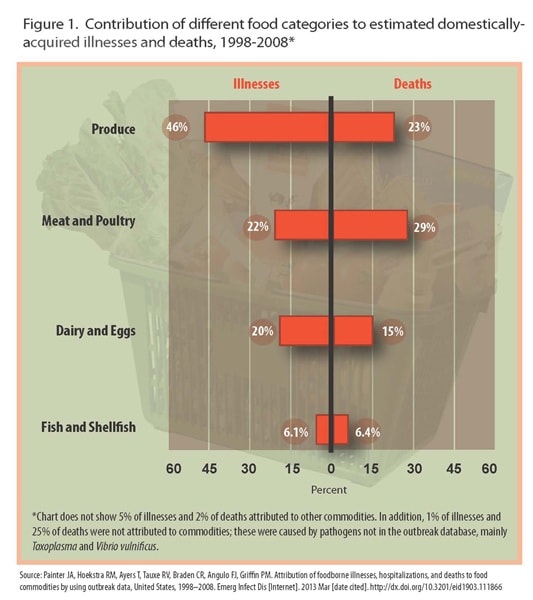Where food or drink is sold for consumption, there is an implied warranty that it is wholesome and fit for consumption. Consequently, where a purchaser of such food or drink is rendered ill, upon and as a result of his consuming the same, he has, and may maintain, an action in damages against the seller for the breach of the implied warranty. Upon proof that the victim purchased the food or drink from the seller, and upon, and as a result of the consuming , the victim became, or was made, ill, a prima facie case of liability is made. The victim is relieved from proving the act of neglect that caused the food to become tainted.
A business or person engaged in the business of selling or otherwise distributing food products who sells or distributes a food product that contained ingredients, without reasonable warning, where such ingredient would not reasonable be expected be within the food can be liable for damages caused as the result of eating the food.
Food Poisoning is prevalent.
CDC estimates that each year roughly 1 in 6 Americans (or 48 million people) get sick, 128,000 are hospitalized, and 3,000 die of foodborne diseases. Estimating illnesses, hospitalizations, and deaths for various types of diseases is a common and important public health practice.


Proving your claim is often the greatest challenge in food poisoning cases. You will have to prove:
- the food you ate was contaminated, and
- the contamination made you sick.
The food you ate was contaminated. You will have to pinpoint the particular food product that made you sick. If there is a time delay — which is quite common — between eating the contaminated food and the onset of symptoms it may be difficult to determine specifically which food or which meal made you sick, unless many others were also made ill by eating the same food product. Often but not always the food may have an unusual taste, smell or texture. The difference way only be slight.
If and when a government health agency becomes involved in an outbreak of food poisoning, locating the source may be difficult. Medical laboratory testing for microbes can be critically important because it can provide solid evidence linking the contaminated product with your illness.
The contamination made you sick. You will also need to prove that your illness was caused by the contaminated food. The best way to do this is to have a stool sample scientifically tested for food poisoning. If you can show that your stool sample contained the same disease-causing microbes that were found in the contaminated food source, you will greatly strengthen your claim. If not, you will need to rely upon your physician to made the medical connection based upon the facts presented by the situation. There needs to be a solid link to make the inference that the contaminated food made you sick.
Symptoms and Signs of Food Poisoning.
Food poisoning symptoms vary with the source of contamination. Most types of food poisoning cause one or more of the following signs and symptoms:
- Nausea
- Vomiting
- Watery diarrhea
- Abdominal pain and cramps
- Fever
The above may start within hours of eating or days, or possibly even weeks later. Sickness caused by food poisoning generally lasts from one to 10 days.
When to see a doctor. This is not medical advise but information taken from Mayo Clinic website which also contains disclaimers.
http://www.mayoclinic.com/health/food-poisoning/DS00981/DSECTION=symptoms
If you experience any of the following signs or symptoms, seek medical attention as recommended by the Mayo Clinic website.
- Frequent episodes of vomiting that interfere with your ability to keep liquids down
- Vomiting blood
- Severe diarrhea for more than three days
- Blood in your bowel movements
- Extreme pain or severe abdominal cramping
- An oral temperature higher than 101.5 F (38.6 C)
- Signs or symptoms of dehydration — excessive thirst, dry mouth, little or no urination, severe weakness, dizziness or lightheadedness
- Difficulty speaking
- Trouble swallowing
- Double vision
- Muscle weakness that progresses downward
Listeria infection is a foodborne illness that can be very serious for pregnant women and people with impaired immune systems. Listeria infection is most commonly contracted by eating improperly processed deli meats and unpasteurized milk products.
Salmonella infection is a common bacterial disease that affects the intestinal tract. Salmonella bacteria typically live in animal and human intestines and are shed through feces. Humans become infected most frequently through contaminated water or food sources.If you suspect a serious case of food poisoning contact an attorney immediately. Our office will assist you in making a report to the local health department in order to begin the process of identifying the cause and preventing other cases.

Cyclospora infection causes watery, and sometimes explosive, diarrhea. The one-celled parasite that causes cyclospora infection can enter your body when you ingest contaminated food or water. Fresh produce is the culprit in many cases of cyclospora infection.
If you have any question about seeking medical treatment use your judgment and act accordingly. We have handled numerous cases against restaurants and food suppliers. If you are affected by any food recalls call us immediately. We will give a free initial consultation and you will not be charged a fee unless we obtain a recovery. All of our payments will derive from any settlement, judgment or recovery.



Leave a Reply